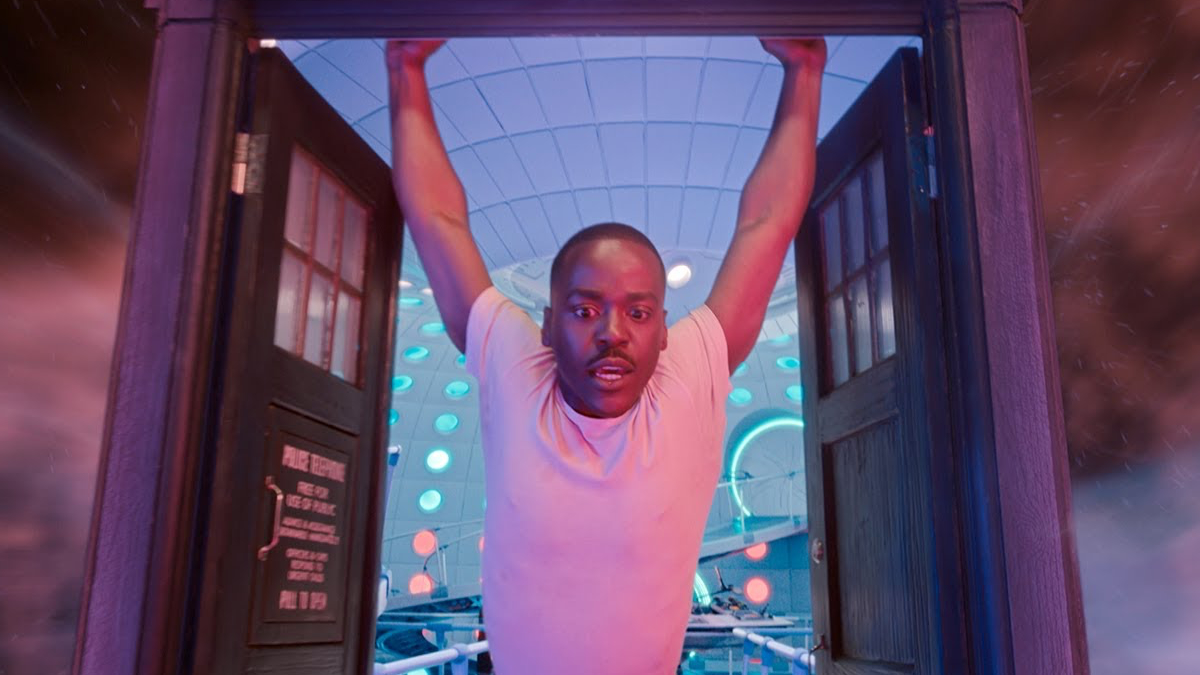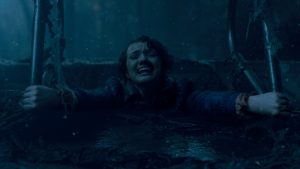
Warning: spoilers for Doctor Who series 14 finale “Empire of Death”
We’ve had a bit of time to digest the finale of this year’s Doctor Who season (and boy, does it feel good to say that knowing we only have to wait until next year for the new one). So while we sit twiddling our thumbs and waiting for Steven Moffat’s Christmas Special, it’s time to do what we Doctor Who fans do best – concoct elaborate theories about minor plot details while handing down authoritative judgements on what the showrunners should do next.
“Empire of Death” thoroughly understood its assignment as a Russell T Davies Doctor Who Finale, giving us spectacle, recurring characters, the death of the universe (for the second time, although the fifth attempt since 2005 by our count), and it least one massive gaping plot hole. It also had breadcrumbs aplenty for future seasons, including the mysterious Mrs Flood who might be Romana, or Clara Oswald (“Clever boy!”), or the Master’s new incarnation, but is almost certainly not the Rani (it’s never the Rani). And of course, there’s the ever-present mystery of Mel Bush – whatever the answer, it’s going to annoy fans of the spinoff media.
So among all that, you can be forgiven for missing a tiny loophole that opened that might bring back the universe’s masters (small M) of high fashion, the Time Lords. But to understand that loophole, you need to understand Sutekh’s evil plan.
Death Hitches a Ride
First, let’s take a look at Sutekh’s evil plan. Instead of getting thrown into the distant future by Tom Baker’s Doctor at the end of Pyramids of Mars, he’s been clinging onto the side of the TARDIS, presumably shuffling over to make room for Captain Jack when necessary.
(Sidebar – when the 15th Doctor used his giant cartoon mallet to whack a second TARDIS into existence, did he create another Sutekh as well?)
Everywhere the Doctor landed since then, Sutekh created a person who resembled the actress Susan Twist (did Davies write that entire series arc just because he saw an actress with that name?) 73 yards away from the TARDIS itself. That person blended in perfectly with their surroundings in exactly the way that the TARDIS doesn’t, and went on to live their lives until Sutekh gave the go signal, at which point they turned everybody into sand.
But then, in a stroke of genius entirely fitting a Russell T Davies-written finale, the Doctor realizes that if you bring death to death, you actually bring life. So he puts an actual lead on Sutekh and drags him off into the time vortex through “all of time and space” to “bring life to the whole flipping universe”, and we get a tour of what we have to assume is a very small selection the planets Sutekh has revived, including familiar names like Telos (although Telos might not have noticed because all the Cybermen there are still frozen in tombs), and others that show off Davies’ passion for making up words. One name was noticeably absent from that list.
But…
“The whole flipping universe.”
Okay, so the first question. If you’re bringing “death to death”, does that mean it could also bring to life people who weren’t killed by Sutekh?
The answer is “If the writer wants”. But just for fun why don’t we say the answer is “No”.
Second question: Did we ever find out how the Master killed off all the Time Lords in “Spyfall“? Could he have had help from an ally who similarly loved wordplay-based pseudonyms? Okay, turning all the Time Lords into sand wouldn’t have left much for him to make Cyber Time Lords out of, but even Sutekh had plenty of gaunt, semi-mummified allies after he did the double-Thanos snap.
Now you might be about to point out that everyone else in the spacetime continuum, from the past and the future, died at the same time when Sutekh unveiled himself, but if you read that sentence back to yourself very slowly you’ll realise it’s not much of an argument.
So it is entirely possible Sutekh was behind the death of the Time Lords, and that his magical mystery tour of the vortex brought them back. And that brings us to our third and final question: Why would you want to do a thing like that?
The Death and Return and Death and Return and Death (and Return?) of Gallifrey
If you’re one of those fans who believes that everything is canon, Gallifrey has been destroyed at least three times – once during the “War in Heaven” in the Eighth Doctor BBC books, once at the end of the Time War (although it later turned out it just got moved a bit) and once, finally, by the Master, when he killed everyone through unknown means then went back and turned the corpses into Cyber Time Lords and some guy the Doctor had just met suicide-bombed the entire planet so that the Doctor had time to get away. (How we miss the Chibnall era.)
That most recent destruction, which ultimately happened because the Master threw a temper tantrum, felt cheap compared to the climax of the war for all existence. It also made you wonder what Tom Baker’s “Curator” (all but said to be a future incarnation of the Doctor) seemed so happy about when he was telling the Eleventh Doctor that Gallifrey might still be out there (for a bit, before it gets blown up again).
Now, obviously we can’t just bring the Time Lords back again. And if you believe that, I’ve got a final destruction of the Daleks and a definitely-dead-for-real-this-time incarnation of the Master to sell you.
But the Daleks and the Master are always going to come back. This is Doctor Who. You might rest its best villains for a little bit, but you’re never really going to completely do away with them.
The Time Lords on the other hand? Well, killing them off before Christopher Eccleston’s Doctor turned up was one of Davies’ master strokes. The Doctor has always been at their best when they are the Mad Person in a Box, pinballing through space and time, going where they feel like, no home, no mission, nothing but whatever they’ve wandered into this week.
Against that, the Time Lords feel like so much baggage, just turning up occasionally to tell the Doctor off, or worse, give them a job.
The Timeless Child twist felt like an attempt to do the same thing – less launching a whole new plot arc than resetting the status quo established in “An Unearthly Child”.
But you can’t really remove stuff from Doctor Who. There used to be a saying that “No one stays dead in comics except Bucky, Jason Todd, and Uncle Ben”, until about 20 years ago when Bucky and Jason Todd both came back. Who works on a similar logic. So, instead of pretending that the destruction Gallifrey is going to stick, we should be thinking about how to bring them back in a way that they can actually unlock some good stories for the Doctor.
Empire of Ages
Of course, before you can ask that question, you have to ask what the Time Lords were good for in the first place. “Not much” is a valid answer – there were many good reasons the kill them off, as we’ve said. But they have had their uses.
In their very first appearance it was fantastic seeing the real fear Patrick Troughton played when he knew they were approaching. Given everything we now know about their funny collars and dubious purpose that might seem unlikely, but “The War Games” is the first time we really get the sense of the Doctor as not just an exile, or a wanderer, but a man who is running from something.
That was the high watermark for Time Lords for a while. From then on most of their appearances were as Basil Expositions when the Doctor needed to be given a mission or warned about some coming threat. Then in 1976 we finally got a proper look at Gallifrey with the unintentionally-hilariously-named “The Deadly Assassin”. Despite the silly name, this “Doctor Who does The Manchurian Candidate” story set the ground rules for Time Lords going forward, and every Time Lord story written since is in one way or another riffing off this one.
This Gallifrey is a parody of a specific idea of Britain, its dusty civil servants, stale bureaucracy and self-important ambition. As we walk its halls of power (Does Gallifrey have any other kind of hall?) it seems that everyone we meet went to the same public school, and the political clashes are largely just a continuation of those classroom grudges.
Blimey, can you imagine living in a place like that?
Of course, then the Time War came along and suddenly we had to take the Time Lords seriously, with the Tenth Doctor looking properly terrified at the prospect of Timothy Dalton’s Rassilon returning to end existence (forgot that one – sixth attempt since 2005). But, as I think we’ve already demonstrated, you can only threaten to end the entire universe so many times before the threat starts to lose its urgency. So maybe the key to bringing the Time Lords back as a going concern is to look back at the more ridiculous Deadly Assassin version of the planet.
The best Doctor Who villains (and the Time Lords are definitely villains) have always been about Empire. Daleks, Cybermen, Sontarans, they are all varieties of expansionist military force, either genocidally annihilating, assimilating or merely conquering everyone in their path. But if the Time Lords work best as a satire of the British, they are now perfectly positioned to show us the threat presented by an ex-Imperial power.
Having fought the mother of all wars against the darkest evil history has ever known, the Time Lords are simply not what they once were. The universe has grown and diversified, new powers have risen, but the Time Lords being who they are, they’re not just going to forget the position they once held. And they aren’t about to start calling themselves the Time Ordinary Citizens either.
Give us Time Lords that are reduced in stature, a bit pathetic, even funny, but still thinking they are somehow Lords of Time, and trying to assert that status in a universe of Oodspheres and Time Agents and Tesselecta who have all come in to fill the gap they left. Time Lords who aren’t powerful, but sly, and bitter, and all the more dangerous for it. The Reform Party in giant frilly collars.
And who would they hate more than the Doctor? The individual who founded, rebelled against, betrayed, destroyed and repeatedly humiliated them?
There is more to this though. In among the Big Finish audios, one tiny bit of lore they added to the timey wimey stew was the idea that Time Lords hated divergent timelines and parallel universes, pruning them much like Loki’s TVA did. What if, post-Time War, the Time Lords decide to resume that work?
Okay, here’s another question. What’s the dullest possible Doctor Who story? No don’t rush to the comments, the correct answer is ‘The Doctor turns up during some great historical tragedy/atrocity but it’s a Fixed Point in Time so rather than saving everyone (which they could do easily) they have to sit back and look A Bit Sad while it happens.’
With the Time Lords back in play, lording it over Time as they are wont to do, the Doctor can get on with what they are best at, which is interfering in everything whether it’s a good idea or not while the Time Lords do their best to stop them.
Doctor Who series 14 is available to stream now on BBC iPlayer in the UK and on Disney+ around the world.
The post Did Sutekh Just Bring Doctor Who’s Time Lords and Gallifrey Back to Life? appeared first on Den of Geek.







